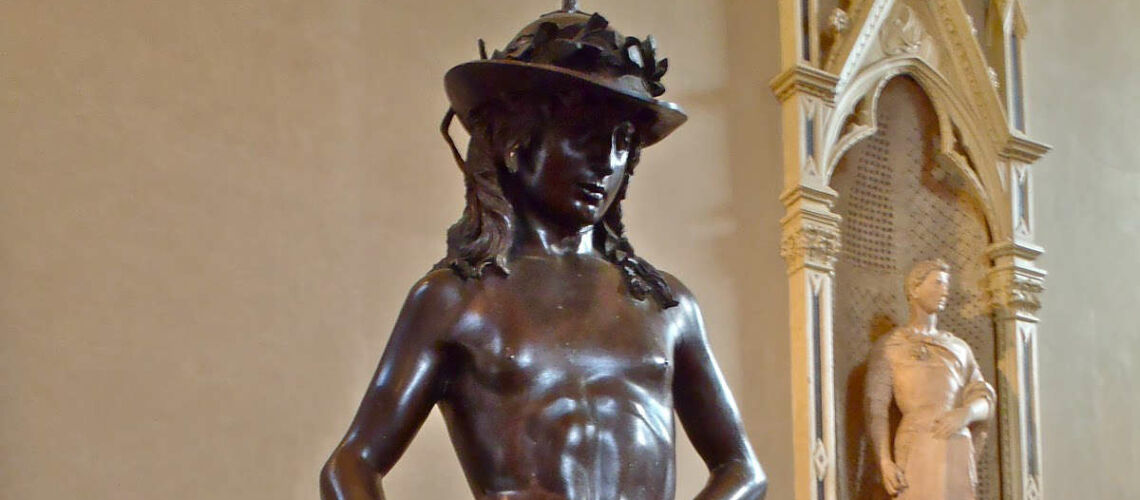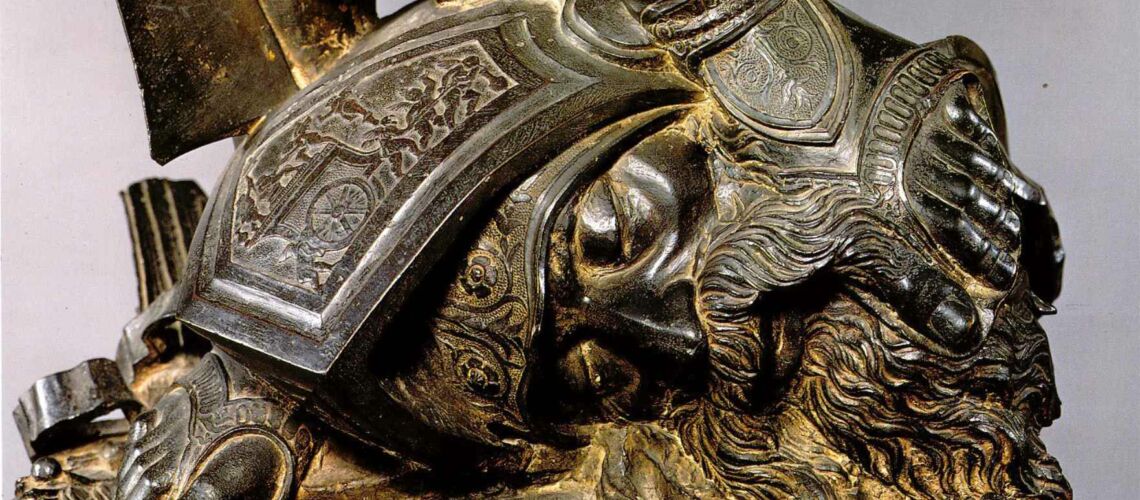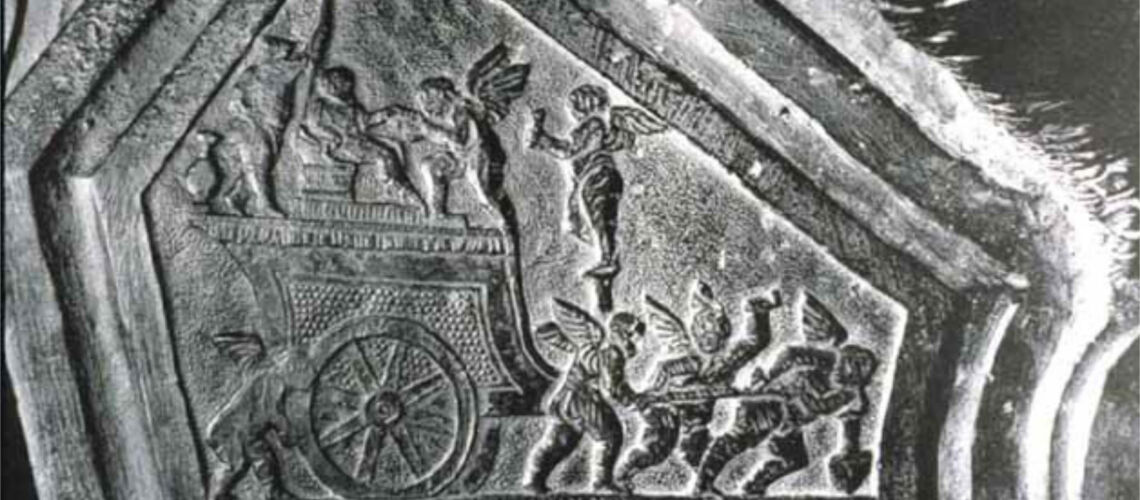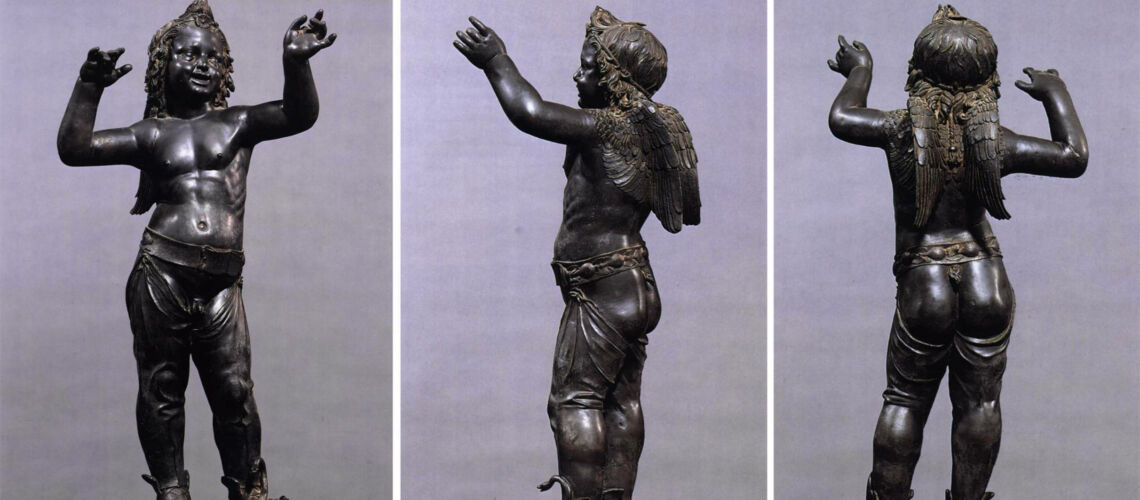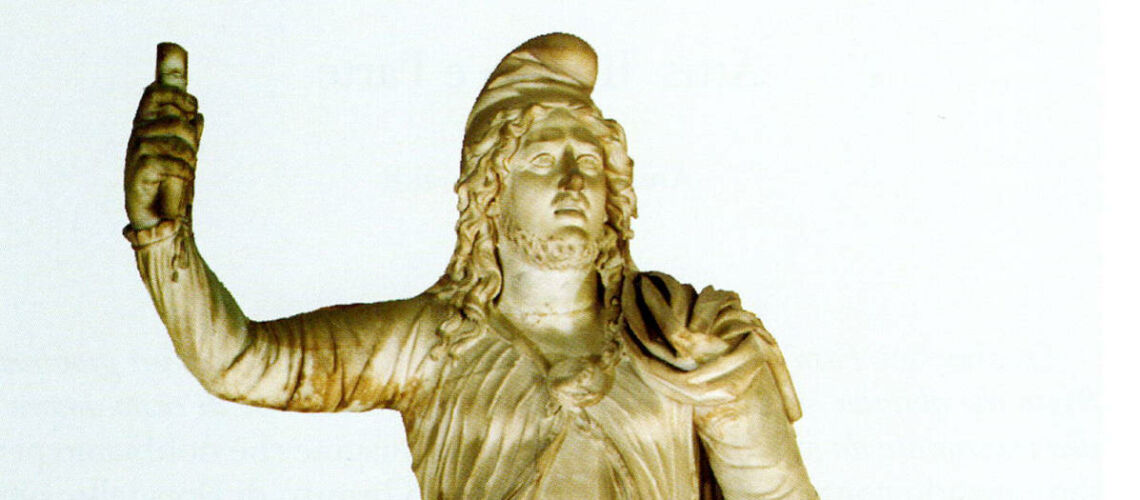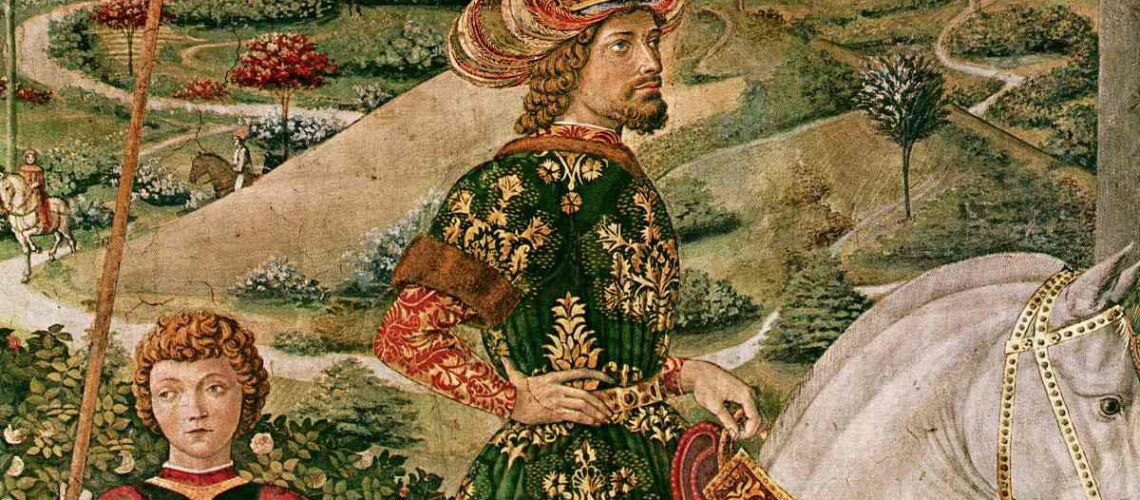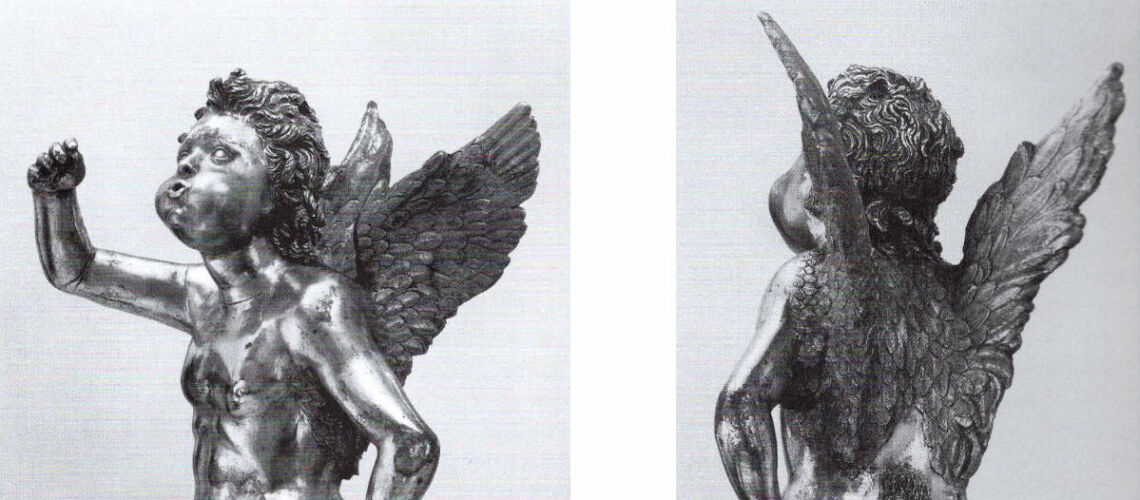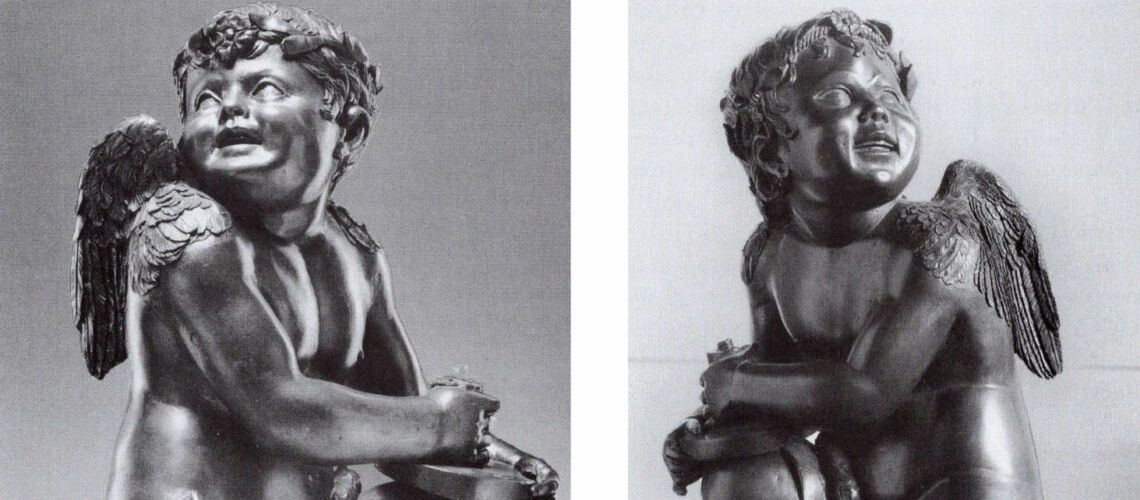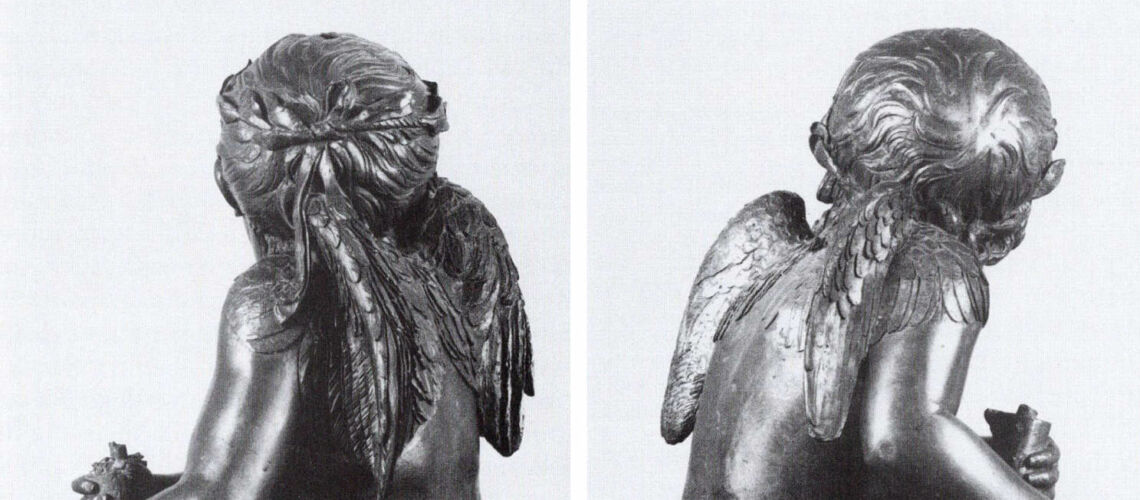Donatello and the Putto in the sculpture
Part V
The forty’s of the ‘400 are the years in which Donatello created his most important and greatest bronze works, in each of which he continues to make his delicious putti appear in one way or another. In the famous bronze David (Bargello Museum, Florence) he sculpts a decorative bas-relief on the helmet of the head of Goliath at his feet in which a scene with a series of putti appears.
The meaning of this scene has been much discussed, since the sword of David wants to indicate precisely the small bas-relief that therefore probably symbolizes the “moral” of the entire sculpture. There is represented a chariot drawn by two winged and naked putti; on the cart a figure without wings is enthroned and receives gifts from two other winged putti; behind the throne appears a naked and fat character with no wings behind, with at his feet, an amphora. The scene seems to be taken from an ancient Roman gem, probably from the Medici collection; it is very probable that the seated figure is Bacchus accompanied by Silenus, and that the winged putto is offering him a cup of wine. Being on the Goliath helmet, it could be the representation of incontinence, pride and arrogance, vices associated with Goliath (and with the tyrannical enemies of Florence) won by the virtue of David (the Republic of Florence).
Attis
It is a bronze statue in all-round, about 104 centimetres high. Although with various attributes, it is a putto standing up, and it is the first time that in the Renaissance a putto is sculpted in all-round in this size, without being an accessory or secondary character. It is absolutely in classic pagan style, so much so that in the 17th century it was taken for an ancient Roman work. Besides being beautiful, it is also enigmatic, there is no sculpture in antiquity with all its features and attributes: it seems that Donatello has invented a new type of creature. He is standing, in a relaxed chiasmus, with both arms raised. He joyfully looks at his left hand where the thumb and middle finger are closed, probably holding something that was lost; he has tangled hair tied by a string that holds a flower in his forehead, he wears a belt around his waist with sculpted poppy caps that supports a sort of stocking-pants that leave his buttocks and genitals exposed; at his feet he has two squat and undefined pairs of wings, he wears sandals with which he tramples a snake. On his shoulders he has two beautiful wings, and at the beginning of his buttocks a small tail.
In ancient times there were putti standing with similar hair and with a similar pose. But they do not have wings on their feet, nor belts with stockings, nor tails, nor snakes to step on. Donatello wanted to transform the classic putto prototype into something with a precise meaning. Several scholars have clashed with this meaning: for Edgard Wind (Misteri pagani del Rinascimento, Adelphi, Milan 1985) is a polymorphous neo-Platonic creation, with the face and wings of Eros, which has Pan’s tail, Attis’s trousers,
the belt of Hypnos, the wings at the feet of Mercury.
For Erwin Panofsky (Renaissance and Renaissance in Western art) it is the allegory of Time that rolls the dice; and in fact Pan’s tail is the symbol of the association of Pan with the universe of which Time holds the fate. The wings on the shoulders and feet, and the snake, are symbols of Time. The barbaric pants are those of Aion, the demon of time of Iranian origin. The poppies of the belt, emblems of sleep and death, represent its dual nature as creator and destroyer. And the missing object that probably had between his fingers was just a dice. Time is a destroyer who plays dice with humanity, our destiny is in his hands.
In a fragment of Heraclius found in the “Refutatio omnium haeresium” (book IX, chapters 3 and 4) of Hippolytus of Rome the Demon of Time is defined as a frivolous child who plays with dice with humanity and our destiny is in his hands. There is this phrase also in Carmina LXXXXV of the Byzantine Gergorio Nazanzieno. When Lorenzo the Magnificent succeeded in 1349 to bring the Council between the Roman and Oriental church in Florence, the emperor of Byzantium John VIII Palaeologus and his numerous court
could have brought to the attention of the Florentine humanists, in a continuous search for classical Greek texts, the fragment of Heraclius and then transferred to Donatello’s work; this collaboration often happened in the workshops of Renaissance artists.
We do not know of this Donatellian masterpiece the date of execution which is in any case hypothesized in the middle of the fifteenth century, nor the client, with any probability the Medici family, or perhaps the Bartolini Salimbeni.
Another putto from Donatello’s workshop is the bronze one of the Metropolitan Museum of New York.
It has stylistic elements that are very similar of those of Donatello, for example the rounded protruding belly like in the Attis, the movement equal to that of the putti on the baptistery of Siena, the movement of the hair, and has some attributes of the Attis: the same type of attack of the wings and the feathers between them on the back, a strange hairy tail, the wings on the feet.
It is born as a putto for a fountain but we do not know when it has been sculpted, we can hypothesize around the middle of the ‘400, and we don’t know for whom it has been executed. Like the Attis, it is one of the first two all-round standing putto
Two other magnificent bronze putti, attributed in the past to Luca della Robbia, are those of the Jacquemart Andre Museum in Paris, but have long since been attributed to Donatello and are dated around 1440.
They are two candle holders, most likely executed by Donatello for the Cantoria del Duomo, where they sat on two corners. Like the Attis, they have wavy hair tied with a thread decorated with leaves that holds the same flower as the Attis on the forehead. Even the expression of the face is very similar to that of the Attis; also the wings are similar to those of the Attis, with the central part of the back covered with feathers.
The expression on the face is also very similar to that of Attis.

